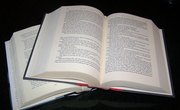Taking notes during a class lecture can help you remember the key points that the teacher or professor discussed. Similarly, taking notes while reading a book can provide you with a useful summary of materials to review before an exam. You may develop your own particular system for note-taking. Some students use different colored pens for different types of information; others may place a star next to especially important information. Following a few guidelines can improve your note-taking.
Step 1
Write down the title of your source and the number or title of the chapter. This way, if you need to go back to the book to clarify information from your notes, you’ll know which book the information came from. At various points in your notes, you may also want to write down page numbers that correspond with key pieces of information.
Step 2
Scan the chapter. Gain a basic understanding of the material before you attempt to filter the information and write notes.
Step 3
Read the chapter again, thoroughly. As you read, write down key terms, events, dates, important people and main ideas. If you’re reading a fiction book, jot down the names of characters and their roles or relationships to each other. In a bookd about Constantinople, your notes should reflect the date it was founded, the date it fell, its relationship to Rome and a very brief summary of its significance during the Crusades.
Step 4
Write in phrases or brief statements and use abbreviations whenever possible. You may develop your own set of abbreviations, however some common ones include “w/” instead of “with,” “&” instead of “and,” “c.” instead of “circa/about” and “est.” instead of “established.” You may also use arrows. For example, write an up-arrow to show that something increased, or a down arrow for a decrease. Write a right-facing arrow to show that one event was the result of the previous event.
Step 5
Leave plenty of white space on your notebook pages. Use a bullet format for lists when appropriate. Do not attempt to write block paragraphs or include a great deal of information. The purpose of taking notes is to boil the information down to its bare essentials. By leaving plenty of white space on your pages, you have the option of writing in brief, additional notes later.
Related Articles
References
Writer Bio
Catherine Chase is a professional writer specializing in history and health topics. Chase also covers finance, home improvement and gardening topics. She holds a Bachelor of Arts in American studies from Skidmore College.











